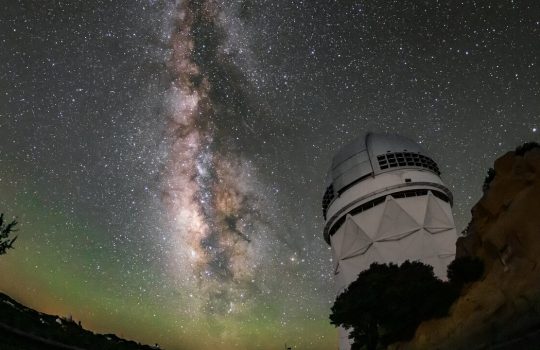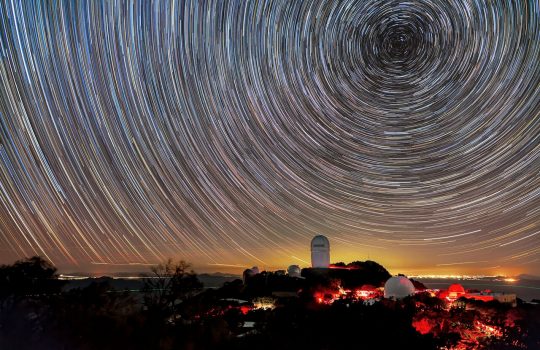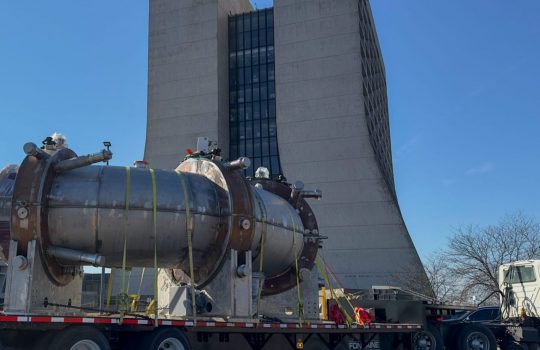The Dark Energy Spectroscopic Instrument seeks to further our cosmic understanding by creating the largest 3-D map of galaxies to date. Below is a press release issued by Lawrence Berkeley National Laboratory announcing first light for the optical lenses of this extraordinary instrument. The U.S. Department of Energy’s Fermi National Accelerator Laboratory is a key player in the construction of this instrument, drawing on more than 25 years of experience with the Sloan Digital Sky Survey and the Dark Energy Survey.
Fermilab contributed key elements to DESI, including the corrector barrel, hexapod and cage. The corrector barrel – designed, built and initially tested at Fermilab – aligns DESI’s six large lenses to within the accuracy of the width of a human hair. This precision is essential to ensure that the images DESI collects are sharp and clear. The hexapod, designed and built with partners in Italy, moves and focuses the lenses. Both the barrel and hexapod are housed in the cage, which was also designed and built by Fermilab. Additionally, Fermilab carried out the testing and packaging of the charge-coupled devices, or CCDs. The CCDs convert the light passing through these lenses from distant galaxies into digital information that can then be analyzed by the collaboration.
Fermilab also provided other components to the project, including the online databases used for data acquisition and the software that will ensure that each of the 5,000 robotic positioners are precisely pointing to their celestial targets.
“DESI promises to be at the core of the next decade of cosmological discoveries,” said Liz Buckley-Geer, a Fermilab scientist and a member of the DESI collaboration. “It’s an amazing project to be a part of, and we’re celebrating this moment with the entire DESI team.”
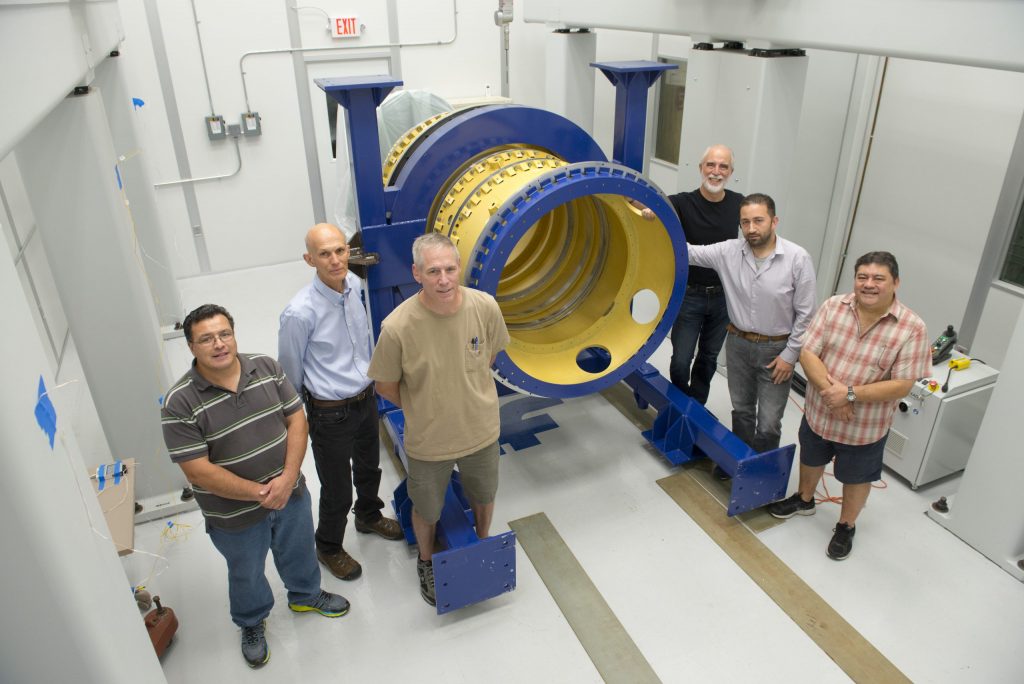
Members of the Fermilab team stand with the lens-holding barrel for the Dark Energy Spectroscopic Instrument. From left: Jorge Montes, Mike Roman, David Butler, Gaston Gutierrez, Giuseppe Gallo and Otto Alvarez. Photo: Reidar Hahn
On April 1 the dome of the Mayall Telescope near Tucson, Arizona, opened to the night sky, and starlight poured through the assembly of six large lenses that were carefully packaged and aligned for a new instrument that will launch later this year.
Just hours later, scientists produced the first focused images with these precision lenses – the largest is 1.1 meters in diameter – during this early test spin, marking an important “first light” milestone for the Dark Energy Spectroscopic Instrument, or DESI. This first batch of images homed in on the Whirlpool Galaxy to demonstrate the quality of the new lenses.
”It was an incredible moment to see those first images on the control room monitors,” said Connie Rockosi, who is leading this early commissioning of the DESI lenses. “A whole lot of people have worked really hard on this, and it’s really exciting to show how much has come together already.”
This phase of the project will continue for about six weeks and will require the efforts of several onsite scientists and remote observers, noted Rockosi, a professor of astronomy and astrophysics at UC Santa Cruz.
When completed later this year, DESI will see and measure the sky’s light in a far different way than this assembly of lenses. It is designed to take in thousands of points of light instead of a single, large picture.
The finished DESI will measure the light of tens of millions of galaxies reaching back 12 billion light-years across the universe. It is expected to provide the most precise measurement of the expansion of the universe and provide new insight into dark energy, which scientists explain is causing this expansion to accelerate.
DESI’s array of 5,000 independently swiveling robotic positioners, each carrying a thin fiber-optic cable, will automatically move into preset positions with accuracy to within several microns (millionths of a meter). Each positioner is programmed to point its fiber-optic cable at an object to gather its light.
That light will be channeled through the cables to a series of 10 devices known as spectrographs that will separate the light into thousands of colors. The light measurements, known as spectra, will provide detailed information about objects’ distance and the rate at which they are moving away from us, providing fresh insight about dark energy.
DESI’s lenses are housed in a barrel-shaped device known as a corrector that is attached above the telescope’s primary mirror, and the corrector is moved and focused by a surrounding device known as a hexapod.
Fermi National Accelerator Laboratory (Fermilab) researchers led the design, construction and initial testing of the corrector barrel, hexapod and supporting structures that hold the lenses in alignment.
“Our entire team is pleased to see this instrument achieve first light,” said Gaston Gutierrez, the Fermilab scientist who managed this part of the project. “It was a great challenge building such large devices to within the precision of a hair. We’re happy to see these systems come together.”
The giant corrector barrel and hexapod, which together weigh about 5 tons, must maintain alignment with the telescope’s large reflector mirror that is 12 meters below, all while compensating for the movement of the telescope’s assemblage of massive components as it swings across the sky.
“This is a big step up. It’s a leap into the future for the Mayall Telescope that will enable exciting new scientific discoveries,” said Michael Levi, DESI’s director and a physicist at the Department of Energy’s Lawrence Berkeley National Laboratory (Berkeley Lab), which is the lead institution in the international DESI collaboration. “The team has been working on the new corrector for the past five years, so it was quite an experience seeing $10 million of optics lifted by the crane during installation.”
The new set of lenses expands the telescope’s viewing window by about 16 times, enabling DESI to map about one-third of the visible sky several times during its five-year mission.
Peter Doel, a professor at University College London, led the team that designed the new optical system. “We had a half-dozen vendors involved with making and polishing the glass. One mistake would have spoiled everything. It’s thrilling to know that they survived the journey and work so well.”
“This was kind of the moment of truth,” said David Schlegel, a DESI project scientist. “We have been biting our nails.”
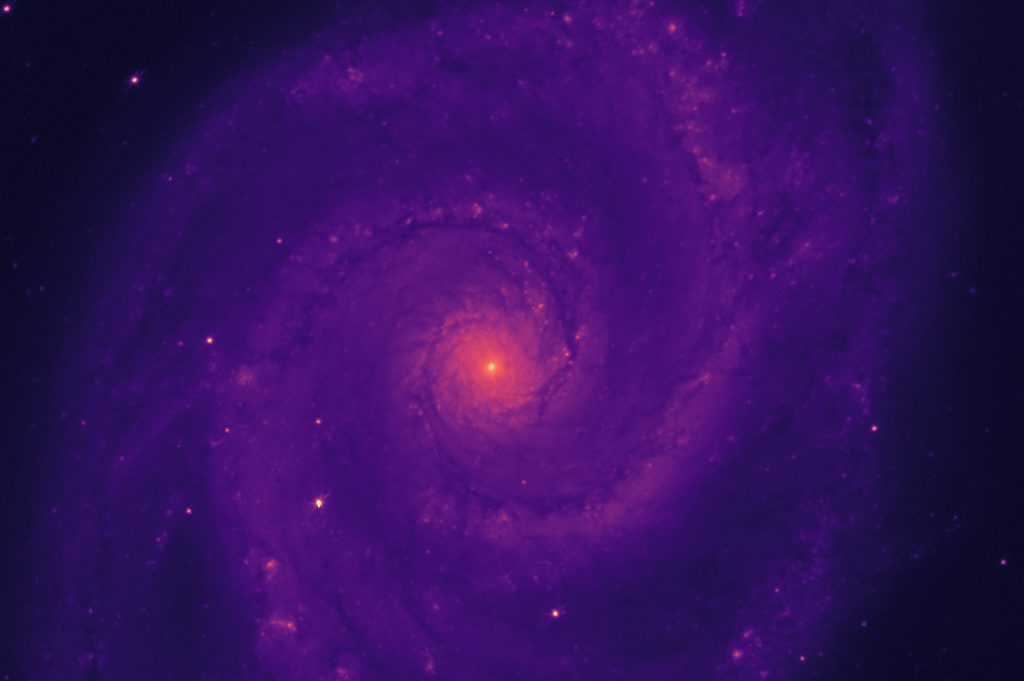
DESI “first light” image of the Whirlpool Galaxy, also known as Messier 51. This image was obtained the first night of observing with the DESI Commissioning Instrument on the Mayall Telescope at the Kitt Peak National Observatory in Tucson, Arizona; an r-band filter was used to capture the red light from the galaxy. Image: DESI collaboration
David Sprayberry, the National Optical Astronomy Observatory (NOAO) site director at Kitt Peak, said, “We have an amazing, multitalented team to make sure that everything is working properly,” including engineers, astronomers and telescope operators working in shifts. NOAO operates the Mayall Telescope and its Kitt Peak National Observatory site.
He noted the challenge in updating the sturdy, decades-old telescope, which started up in 1973, with high-precision equipment. “Ultimately we must make sure DESI can target to within 5-micron accuracy – not much larger than a human hair,” he said. That’s a big thing for something so heavy and big.” The entire moving weight of the Mayall Telescope is 375 tons.
Rockosi said there was intensive pre-planning for the corrector’s early testing, and many of the tasks during this testing stage are focused on gathering data from evening observations. While DESI scientists have created automated controls to help position, focus and align all of the equipment, this testing run allows the team to fine-tune these automated tools.
“We’ll look at bright stars and test how well we can keep the telescope targeted in the same place and measure image quality,” Rockosi said. “We will test that we can repeatedly and reliably keep those lenses in the best possible alignment.”
The precision testing of the corrector is made possible by an instrument – now mounted atop the telescope – that was designed and built by Ohio State University researchers. This 1-ton device, which features five digital cameras and measuring tools supplied by Yale University, and electronics supplied by the University of Michigan, is known as the commissioning instrument.
This temporary instrument was built at the same weight and installed at the same spot where DESI’s focal plane will be installed once it is fully assembled. The focal plane will carry DESI’s robotic positioners. The commissioning instrument simulates how the telescope will perform when carrying the full complement of DESI components and is verifying the quality of DESI’s lenses.
“One of the biggest challenges with the commissioning instrument was aligning all five cameras with the corrector’s curved focal surface,” said Paul Martini, an astronomy professor at Ohio State University who led the R&D and installation of the commissioning instrument and is now overseeing its use. “Another was measuring their positions to a few millionths of a meter, which is far more precise than most astronomical instruments.” This positioning will ensure truer measurements of the lenses’ performance.
He said he is looking forward to the installation of DESI’s focal plane later this year. That will pave the way for DESI’s official “first light” of its robotic positioners and the start of its galaxy measurements.
“What got me excited about this field in the first place was going to telescopes and taking data, so it will be fun to have this next step,” he said.
###
DESI is supported by the U.S. Department of Energy’s Office of Science; the U.S. National Science Foundation, Division of Astronomical Sciences under contract to the National Optical Astronomy Observatory; the Science and Technologies Facilities Council of the United Kingdom; the Gordon and Betty Moore Foundation; the Heising-Simons Foundation; the National Council of Science and Technology of Mexico; the Ministry of Economy of Spain; and DESI member institutions. The DESI scientists are honored to be permitted to conduct astronomical research on Iolkam Du’ag (Kitt Peak), a mountain with particular significance to the Tohono O’odham Nation. View the full list of DESI collaborating institutions, and learn more about DESI here: desi.lbl.gov.
Founded in 1931 on the belief that the biggest scientific challenges are best addressed by teams,Lawrence Berkeley National Laboratoryand its scientists have been recognized with 13 Nobel Prizes. Today, Berkeley Lab researchers develop sustainable energy and environmental solutions, create useful new materials, advance the frontiers of computing, and probe the mysteries of life, matter, and the universe. Scientists from around the world rely on the Lab’s facilities for their own discovery science. Berkeley Lab is a multiprogram national laboratory, managed by the University of California for the U.S. Department of Energy’s Office of Science.
DOE’s Office of Science is the single largest supporter of basic research in the physical sciences in the United States, and is working to address some of the most pressing challenges of our time. For more information, please visit science.energy.gov.
The National Optical Astronomy Observatory (NOAO)is the national center for ground-based nighttime astronomy in the United States and is operated by the Association of Universities for Research in Astronomy (AURA) under a cooperative agreement with the National Science Foundation Division of Astronomical Sciences.
The National Science Foundation (NSF) is an independent federal agency created by Congress in 1950 to promote the progress of science. NSF supports basic research and people to create knowledge that transforms the future.
The Heising-Simons Foundation is a family foundation based in Los Altos, California. The Foundation works with its many partners to advance sustainable solutions in climate and clean energy, enable groundbreaking research in science, enhance the education of our youngest learners, and support human rights for all people.
The Gordon and Betty Moore Foundation, established in 2000, seeks to advance environmental conservation, patient care and scientific research. The Foundation’s Science Program aims to make a significant impact on the development of provocative, transformative scientific research, and increase knowledge in emerging fields.
The Science and Technology Facilities Council (STFC) of the United Kingdom coordinates research on some of the most significant challenges facing society, such as future energy needs, monitoring and understanding climate change, and global security. It offers grants and support in particle physics, astronomy and nuclear physics; visit www.stfc.ac.uk.

